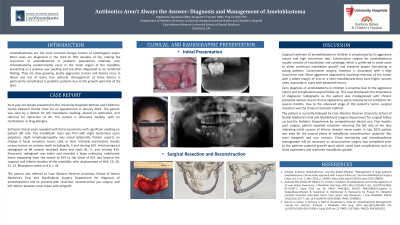Oral Pathology
470 - Antibiotics Aren’t Always the Answer: Diagnosis and Management of Ameloblastoma


Madeleine Tawadros, DMD
Resident
Case Western Reserve University — UH Rainbow Babies and Children’s Hospital, Cleveland, OH
Case Western Reserve University
Cleveland, Ohio, United States- MF
- YA
Ying An, DDS PHD
CWRU
- MF
Margaret Elaine Ferretti, DMD
Program Director
Case Western Reserve University
Rainbow Babies and Children's Hospitals, Case Western Reserve University
cleveland, Ohio, United States
Presenting Author(s)
Co-Author(s)
Program Director(s)
Introduction: Ameloblastomas are the most common benign tumors of odontogenic origin. Most cases are diagnosed in the third to fifth decades of life, making the occurance of ameloblastoma in pediatric populations relatively rare. Ameloblastomas predominantly occur in the molar region of the mandible, presenting as a painless jaw swelling and are most often diagnosed in children as an incidental finding. They are slow growing, locally aggressive tumors and recurr in about one out of every four patients. Management of these lesions is particularly complicated in pediatric patients due to the growth potential of the jaws.
Case Report: This case report discusses an 8 year old female presenting with advanced ameloblastoma following several months of misdiagnosis. This patient was seen by a dentist for left mandibular swelling, placed on antibiotics, and referred to University Hospitals Rainbow Babies and Children’s Hospital for extraction of #K. The patient who is otherwise healthy, presented to pediatric dentistry with facial asymmetry from a significant swelling on her left side. No carious lesions were noted clinically. A panoramic radiograph was taken to reveal a large unilocular lesion expanding beyond the angles of the mandible and displacing several teeth. This report will emphasize the importance of diagnostic radiographs and detail surgical intervention methods for advanced lesions in pediatric patients.
Identify Supporting Agency and Grant Number:

.jpg)